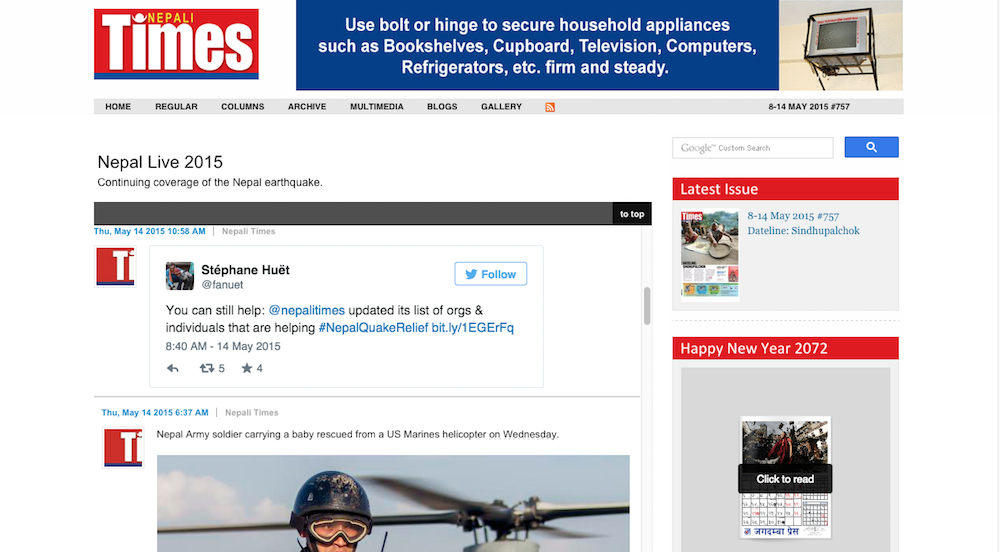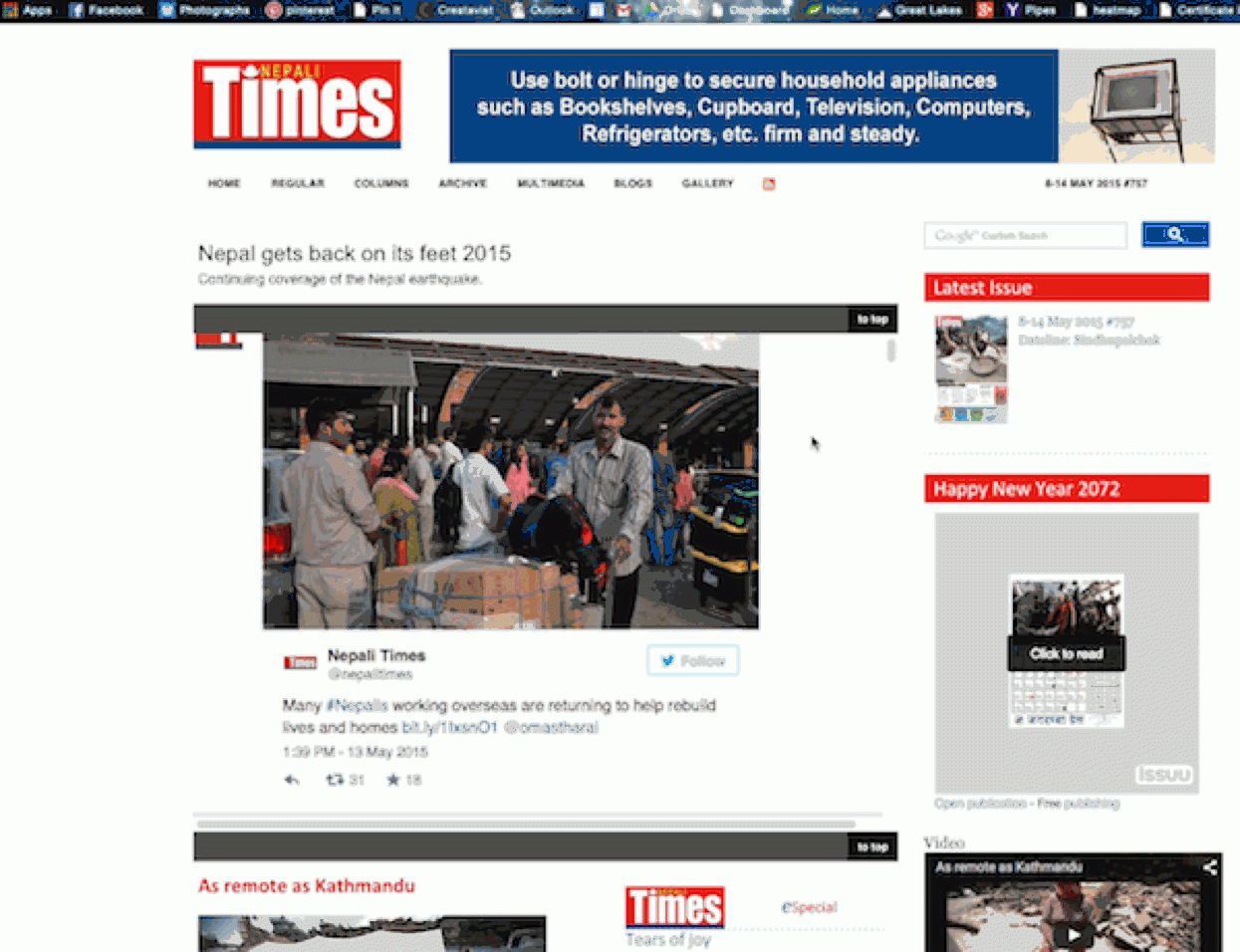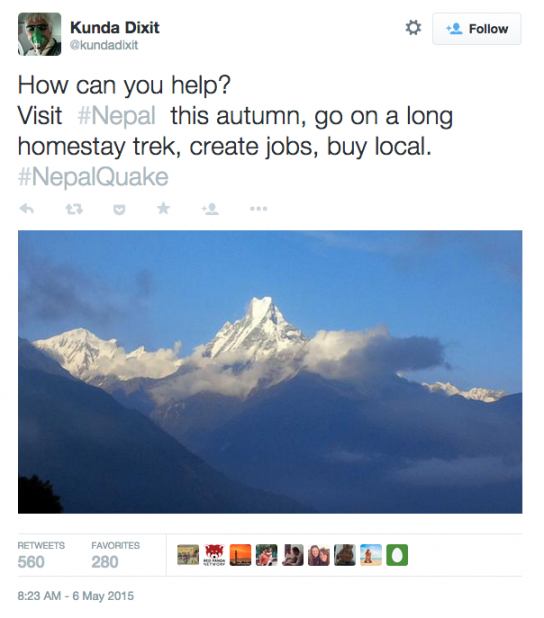Bringing Live Blog to the Nepali Times

On April 25th, 2015, originating in the Nepali village of Gorkha, the country's deadliest earthquake since 1934 began its destructive path. Killing more than 8,000 people and injuring more than double that amount, the quake was felt in India, China and Bangladesh, it triggered an avalanche on Mt.Everest and the Langtang valley, and left thousands homeless across the region.
Far from ending, the humanitarian crisis has only grown in the wake of the disaster. Critical infrastructure damage is limiting the rate at which aid and supplies are able to reach those in need.
The international community has responded both financially and with supplies. There are currently more than 4,000 aid workers in place and hundreds more working to provide relief remotely.
Much remains to be done to help the people of Nepal.
Disaster reporting can be difficult, even for long-time journalists. However, being able to provide useful information during a crisis is one of the main reasons why news organisations exist. For people who have not been through a disaster, it can be hard to understand the chaos that can arise during one, and subsequently, the importance of reporting from trusted news organisations in the region. When the earthquake occurred in Nepal, we immediately turned our attention to a news organisation that we have had ties to since its inception: the Nepali Times.
Bringing Live Blog to the Nepali Times
Sourcefabric has known the founder of Nepali Times, Kunda Dixit, for many years. He came to Prague in 2011 to speak at our Mediafabric conference on New Forms of Journalism in Asia. Sourcefabric Managing Director Sava Tatić visited The Nepali Times a month prior to the earthquake to discuss opportunities for collaboration, one of which was to work together to set up a Live Blog instance. Little did we know that we would be working with them under such extreme circumstances when the earthquake struck a mere three weeks later. After the quake, we sent out a tweet offering our help to Kunda. He got back to us a few days later, and we started implementing a live blog on their website right away. It went live on the 6th of May.
Founded in 2000, the Nepali Times is a weekly English-language newspaper. A widely read paper, the organisation is active on social media with 11,000 followers on Facebook and over 75,000 followers on Twitter.
The Nepali Times opted to devote the main section of their homepage to the live blog to report on real-time news related to the earthquake. Their live blog contains content sourced primarily from internal reporters and articles from their own paper. All the information used in their live blog comes directly from staff members or from trusted sources, enabling the Times to sidestep verification issues.
As an English speaking newspaper with direct access to what is happening on the ground, this newspaper provides a valuable vantage point to the rest of the world.
In a breaking news situation, such as a natural disaster, speed of reporting and flexibility are key factors. Most news organisations direct their attention to Twitter during disaster reporting. Using Live Blog offers news organisations the option to pull content not only from their Twitter, but also from their reporters' feeds, YouTube videos, Flickr images, and more into one continuous stream placed directly on their site. "Previously we would only use Twitter if we had constant updates on a certain topic", said Nepali Times Online Producer, Ayesha Shakya. "The live blog has made it possible for readers without Twitter (or who aren't active on Twitter) to follow our updates constantly."

We recently released our Live Blog mobile app, which turned out to be perfect timing for use by the Times. Mobile reporting has become increasingly important during disaster reporting situations.
"We built the Live Blog mobile app for use cases just like this one," says Sourcefabric's Director of Innovation, Douglas Arellanes.
Using a live blog adds a sense of real-time coverage to something that can otherwise be really cumbersome. To cover a major event live on your news organisation's website takes a long time. You can’t do it from mobile, and more than likely, there isn't a good option set up in your CMS to do so. A live blog allows you to retain your branding and have control over the entire experience. Readers that were already visiting your news site can now get relevant and continuous information aggregated into a single stream.
A live blog is able to combine two styles of coverage into one. While it is a written medium, it also mimics the properties of a live broadcast. For many events, the designated live bloggers announce themselves and then serve to provide continuity and context for those joining the live coverage of that particular event. "The most successful live blogs are often written like textual versions of radio broadcast," Arellanes stated. "This style has typically been reserved for broadcast media, but now we are seeing this new written form of aggregated instantaneous coverage being used in live blogs."
Adopting a live blog was simple for the Nepali Times as they were already savvy when it came to the use of digital tools, and they also had extensive experience in real-time reporting. It was an easy transition for them as they already had the fundamental skills necessary to create a successful live blog.
As a general rule, it is important for news organisations to have a plan in place for breaking news coverage. This becomes especially useful to have when a natural disaster occurs. News organisations should make a plan for coverage beforehand, understand how to switch their front page template to live coverage, and know who their contacts are among the live responders. Live coverage should be the default mode during a breaking news situation. In the case of the Nepali Times, it was wonderful how many of their team members were already active on social media. Many of them are opinion leaders and this has greatly helped their real-time coverage.
How can you help?
Much remains to be done to help Nepal get back on its feet. There are many ways to provide relief for the people of Nepal. The Times recently published a list of agencies in need of donations, relief camps, online resources, donation links, materials needed, volunteers needed, and more. "Aid needs to be distributed evenly and precautions need to be taken before the monsoon season which is just around the corner" Shakya cautioned. "Shelters that can withstand the weather need to be made as soon as possible and sanitation needs to be made a priority to prevent an outbreak of an epidemic."
And, of course, you can always plan your next trip to Nepal this fall to help bring much-needed tourism revenue to the area."Our economy has taken one of the biggest hits from the earthquake and tourism is one way to get us back on track" says Shakya. "Although the focus has only been on affected areas, there are still many beautiful places in Nepal that have not been affected. With trekkers and tourists back in Nepal, I believe we can rebuild our country again."
#VisitNepalAutumn2015

